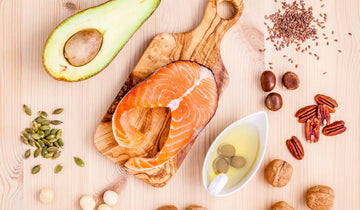Discover why you must include omega 3 and omega 6 fatty acids in your diet
for Baia Food en Feb 21, 2025
Tabla de contenidos
We increasingly hear that fats are essential for the proper functioning of our bodies and should be part of our diet. Our bodies need fat for various functions, such as producing hormones, supporting and protecting the plasma membrane of our cells, and they are an essential component for the proper functioning of our brain.
1. What are Omega 3 and Omega 6 fats used for?
We consume fats through our diet, but we must keep in mind that there are several types and sources of fats. Specifically, there are two essential fatty acids: omega-3 and omega-6. What does it mean to say they're essential? Well, our body is unable to synthesize them, and therefore we must acquire them through proper nutrition.
Omegas are involved in the formation of cell membranes, brain development, blood vessel elasticity, coagulation, and inflammatory and immune response.
Now, we must differentiate them:
- The Omega 6When we ingest them, they are transformed into leukotrienes, which are inflammatory substances. For example, when we have a wound, our body activates an alert system because inflammation has occurred, and these omega-6s are useful for repairing wounds or any physical damage.
- The Omega 3, when we ingest them they are transformed into docosahexaenoic acid (DHA) and eicosapentaenoic acid (EPA). These two acids are very important, since they are ANTI-INFLAMMATORY DRUGS, anticoagulants and prevent uncontrolled cell development.

2. Classification of fats
The function of fats is to provide us with structure and energy, and they are present in both animal and plant-based foods.
They are classified as fatty acids, triglycerides, phospholipids, lipoproteins, and steroids. We'll focus on fatty acids, which are classified as:
- Saturated fatty acids (butyric, lauric, palmitic, stearic and myristic).
- Unsaturated fatty acids: Within these they are classified as:
- Monounsaturated fatty acids: Oleic acid (Olive oil, avocado and peanuts, organic açai).
- Polyunsaturated fatty acids: Linoleic, linolenic and arachidonic acid (flax seed oils, sesame, wheat germ, evening primrose, pumpkin, borage, etc.).
| Omega 6 Series | Omega 3 Series |
| GLA: Evening Primrose and Borage Oil | TO THE: nuts, hemp, chia |
| DGLA | EPA: Blue Fish |
| AA: Arachidonic Acid | DHA: Algae (Spirulina) |
3. Omega 3 and Omega 6 imbalance
Stress, high insulin levels, low omega-3 levels, and excessive consumption of red meat cause an increase in arachidonic acid (AA), producing an inflammatory effect in our bodies. It exerts a procoagulant (the ability to form clots in our arteries) and vasoconstrictor (reducing the diameter of our blood vessels) effect.On the other hand, Eicosapentaenoic Acid (EPA) does the opposite of AA, since It exerts an anti-inflammatory, anticoagulant and antivasoconstrictor action.
Ideally, we should consume both omegas in the right proportion. But unfortunately, with today's diet, society is consuming more omega-6s, and the balance of these omegas is unbalanced.
This excess of Omega 6 It produces inflammation in our body, and this inflammation is what causes the vast majority of chronic inflammatory diseases.
Therefore, it is necessary to maintain a balanced balance of these fatty acids and ingest them with foods rich in omega 3 and omega 6.
But be careful! Don't stop consuming omega-6 now, as it's necessary; what you need to reduce are trans fats.
The trans fats These are the industrially manipulated omega 6s found in pastries, chips, margarines, and refined vegetable oils. These types of foods are the ones we should eliminate since they do not provide anything good for our health, and they are the ones that cause current chronic diseases.

4. Benefits of consuming omega 3
- Anti-inflammatory: Omega 3s reduce the production of substances that cause inflammation.
- They contribute to the maintenance of the cardiac function, improving the markpains that promote cardiovascular disease.
- They regulate and reduce the levels of the blood pressure
- They maintain constant levels of triglycerides in blood
- Reduce the levels of cholesterol in the blood, specifically LDL (“bad cholesterol”) and maintains constant HDL and LDL levels.
- Fetal brain development, which is why it is indicated during pregnancy.
- Greater visual acuity. Omega 3 has been shown to be a key component for the retina of the eye and the brain. Help to improve vision problems.
- Improve sleep: Low levels of omega 3 have been shown to cause sleep problems in both children and adults.
- Helpto improve the symptoms of the rheumatoid arthritis, since omega-3 fatty acids increase calcium levels so that it is efficiently fixed in the bones and reduces the inflammation of the bones and joints associated with this disease.
- Reduces the risk of Alzheimer's disease and dementia.
5. Foods rich in Omega 3 and Omega 6
Where are the Omega 6?
- Plant Source: in vegetable oils such as sunflower, corn, and soybean (and their respective seeds)
- Animal Source: They are found in the form of arachidonic acid and are found in red meats, viscera, dairy products and eggs.
Where are the Omega 3?
- Plant Source: chia seeds, hemp seeds, walnuts and a source of green vegetables such as spirulina algae.
- Animal Source: oily fish (salmon, tuna, mackerel and sardines), seaweed and breast milk.

Therefore, the recommendation is to increase the intake of oily fish, nuts, seeds and algae to provide omega-3s in our diet. Regarding omega-6 intake, it's easily found in our daily diet and we consume it without problems. If, for any reason or condition, we don't get it from these sources, supplementation is a good alternative to keep us away from inflammation.
That said, we can say that fats are necessary and good for our health. If you haven't read the post by Not all fats are bad, I attach the link so you don't miss it. Of course, we should always choose sources of healthy fat that provide us with benefits such as chia seeds, hemp, nuts, fish, and avocado.









